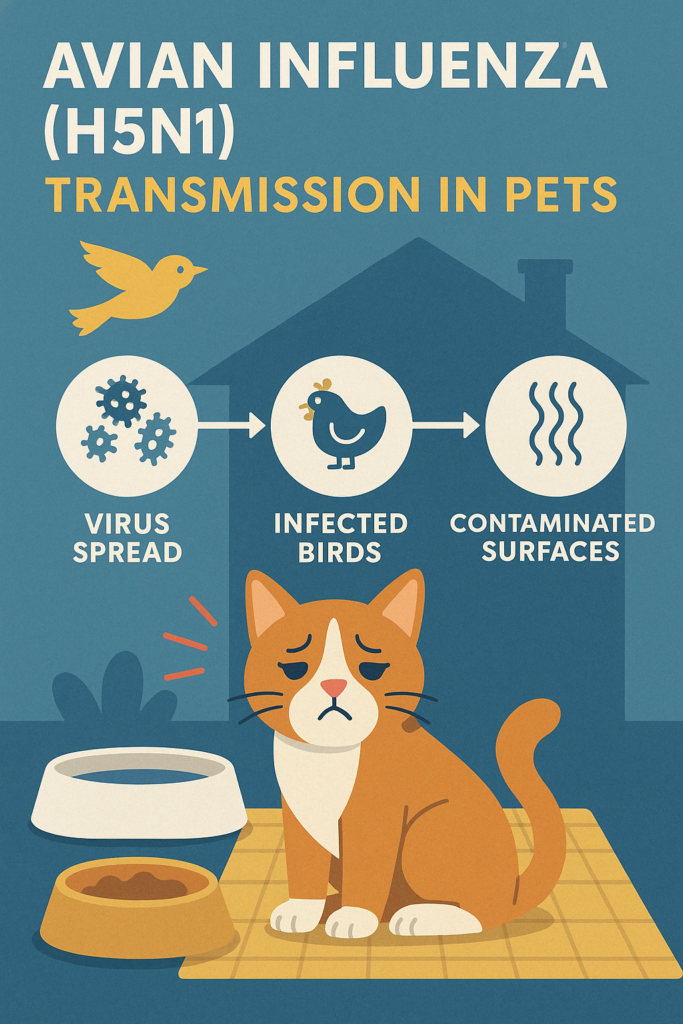Overview of Avian Influenza and Its Transmission
Avian influenza (H5N1) is a highly contagious viral infection primarily affecting birds but recently emerging in mammals, including domestic cats. Avian influenza in cats is a growing concern because felines can contract the virus by consuming infected birds or through close contact with contaminated environments.

Key Points:
- Zoonotic Potential: Though rare, H5N1 poses risks to multiple species, raising concerns for human and animal health.
- Transmission Routes: Ingestion of infected prey, exposure to contaminated surfaces, or respiratory droplets.
Understanding these pathways is critical for reducing the risk of feline respiratory infections linked to bird flu.
Recent Cases of H5N1 in Domestic Cats
In 2024, several U.S. states reported confirmed cases of H5N1 in domestic cats, particularly in regions with outbreaks among wild birds. Veterinarians observed that cats with outdoor access or proximity to infected birds were at higher risk.
Case Studies Highlighting Transmission Routes:
- A cat in Minnesota contracted H5N1 after hunting an infected duck.
- In New York, several shelter cats fell ill after exposure to infected avian populations.
These incidents emphasize the importance of preventing bird flu in pets by limiting contact with potential sources.
Symptoms of Avian Influenza in Cats
Recognizing the signs early can be life-saving. Common H5N1 symptoms in domestic cats include:
- Respiratory Distress: Sneezing, coughing, nasal discharge.
- Fever and Lethargy: High temperature and reduced activity levels.
- Digestive Upset: Vomiting or diarrhea in some cases.
- Neurological Symptoms: Rare cases report seizures or disorientation.
🔗 Related: Understanding Feline Respiratory Diseases (to dive deeper into symptom recognition)
Preventive Measures for Cat Owners
Minimizing exposure to the virus is the most effective strategy. Practical preventive measures for bird flu in cats include:
Guidelines for Indoor and Outdoor Cats
- Keep Cats Indoors: Especially during local avian influenza outbreaks.
- Monitor Outdoor Time: If outdoor access is necessary, supervise activities.
- Avoid Feeding Raw Poultry: Raw meat could harbor the virus.
- Disinfect Shared Spaces: Regularly clean feeding areas, bedding, and litter boxes.
🔗 Related: Preventing Zoonotic Diseases in Pets (for comprehensive preventive strategies)
Impact on Multi-Pet Households
- Isolate Sick Pets: Immediate separation to prevent virus spread.
- Hygiene Practices: Wash hands thoroughly after handling pets.
- Routine Veterinary Checkups: Early detection helps in multi-pet settings.
When to Seek Veterinary Care
Early intervention can drastically improve outcomes. Seek veterinary attention if your cat shows:
- Persistent coughing or breathing difficulty.
- Loss of appetite lasting more than 24 hours.
- Neurological signs like stumbling or seizures.
Veterinarians may conduct diagnostic tests such as PCR assays to confirm H5N1 infection.
🔗 Related: When to Visit the Vet: Signs Your Cat Needs Immediate Attention
Quick Tips for Cat Owners:
- Keep cats indoors during avian flu outbreaks.
- Avoid feeding uncooked poultry or game birds.
- Stay updated on local wildlife health reports.
- Prioritize routine health screenings.
FAQ: Avian Influenza and Cats
Q: Can indoor cats contract avian influenza?
A: While rare, indoor cats can be exposed if owners bring contaminated materials inside or feed uncooked infected poultry.
Q: Is avian influenza transmissible from cats to humans?
A: Current evidence suggests transmission from cats to humans is extremely rare but not impossible, especially in immunocompromised individuals.
Q: How is H5N1 diagnosed in cats?
A: Diagnosis typically involves PCR testing of respiratory or fecal samples.
Final Thoughts
The emergence of avian influenza in domestic cats is a pressing concern that demands attention from pet owners. By understanding transmission risks, recognizing early symptoms, and taking preventive measures, cat owners can significantly reduce the threat of infection. Staying vigilant and maintaining strong communication with your veterinarian ensures the best protection for your feline companions.
Explore More: Understanding Feline Respiratory Diseases | Preventing Zoonotic Diseases in Pets | When to Visit the Vet: Signs Your Cat Needs Immediate Attention
